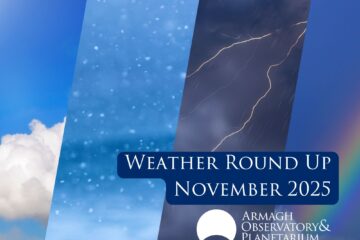MILD MARCH, DRIER AND DULLER THAN AVERAGE
Armagh Observatory reports that March 2021 was warmer, drier and duller than average. This March was the warmest at Armagh for four years, the dullest for eight years, and equally dry as March 2020.
Total precipitation was 44.8 mm (1.76 inches) including four trace values, that is, 44.6 mm if trace values are ignored. This is approximately 80% of the long-term (1838-2020) average March precipitation at Armagh and 75% of the most recent (1991-2020) 30-year average. The total precipitation was the same as that for the previous year, which itself was the driest at Armagh since March 2016. The wettest day was the 10th with 9.2 mm (0.36 inches) of rainfall, followed by the 25th with 6.9 mm.
Hail was reported on the afternoon of the 12th and 26th, the latter also providing an example of silent lightning and later in the afternoon a rainbow. Snowflakes were also observed on the afternoon of the 26th, followed in the evening by light snow and sleet.
Thunder was noted during early evening of the 10th and around mid-afternoon on the 11th. A flock of approximately 60 gulls was observed flying south around the time of observation (09:00 GMT) on the 11th. A prominent moon halo was seen around the waxing gibbous moon on the 24th.
The mean monthly temperature was 7.75 degrees Celsius (45.9 F), which is approximately 1.9 C warmer than the long-term (1796-2020) March average at Armagh and 1.0 C warmer than the corresponding most recent (1991-2020) 30-year average. This was the warmest March at Armagh for four years, that is, since an average March temperature of 8.2 C was recorded in March 2017.
It is interesting to note how rapidly average March temperatures at Armagh have risen over the last approximately 30 years. Whereas the 1961-1990 30-year average was a little over 6.0 C, the most recent (1991-2020) 30-year average is 6.75 C.
The highest maximum air temperature was 18.0 C on the 30th, preceded by 16.2 C on the 29th and 15.5 C on the 28th. The highest minimum air temperature was 11.2 C on the 30th, which was the fifth-highest March minimum air temperature at Armagh since records of maximum and minimum daily temperatures commenced around 1843. This was followed by 9.1 C on the 31st. The lowest maximum air temperature was -1.9 C on the 1st, followed by -1.5 C on the 2nd.
There were 11 nights with ground frost (minimum grass temperature less than or equal to zero), of which the coldest two were -7.6 C on the 7th preceded by -7.5 C on the 1st. There were just two nights with nighttime air frost (minimum air temperature less than or equal to zero).
With a total of 72.6 hours of strong sunshine March 2021 was much cloudier than average, registering approximately 71% of the long-term (1881-2020) March average number of hours of strong sunshine and 70% of the most recent (1991-2020) 30-year average. This was the dullest March at Armagh for eight years, that is, since the exceptionally dull March 2013 (52.0 hours of strong sunshine). The sunniest day was the 16th with 9.6 hours of strong sunshine followed by the 26th with 7.7 hours.
These data refer to observations at Armagh Observatory, which has been recording the weather at Armagh since 1795.
For further information, please contact:
Professor Mark E. Bailey Emeritus Director of Armagh Observatory Armagh Observatory and Planetarium College Hill Armagh BT61 9DG Tel: 028-3752-2928
E-mail: mark.bailey@armagh.ac.uk



0 Comments